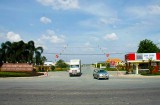Binh Duong provincial People’s Committee issues Decision No. 33/2020/QD-UBND to determine specific land-use prices in the province
Recently, Binh Duong provincial People's Committee issued Decision No. 33/2020/QD-UBND dated December 22, 2020 (Decision 33) on regulating the land price adjustment coefficient in 2021 in the province of Binh Duong. The Decision has some changes compared to Decision No. 37/2019/QD-UBND dated December 20, 2019 (Decision 37). In order to promptly inform readers, Binh Duong Newspaper reporter had an interview with Nguyen Thi Bich Thuy, Director of Sub-Department of Land Management under Department of Natural Resources and Environment about this issue.

Specific determination of land-use prices is a contribution to the assurance of price matching to the market, creating driving force for local economic development. In this photo: Midori Park Project of Binh Duong New City
- Recently, Binh Duong provincial People's Committee issued Decision 33 on the regulation of land-use price adjustment coefficient in 2021 in the province. Could you tell us about the need to issue the K coefficient?
- As a rule, the coefficient K must be issued to apply from January 1 every year. In order to determine the specific land-use price in the province and to ensure that the land-use price issued by the PPC and applied in 2021 when multiplied by the K coefficient will match the popular land-use price in the market, the PPC issued a decision regulating the K coefficient to apply from January 1, 2021, replacing Decision 37 on regulating the land-use price adjustment coefficient in 2020 in the province.
- Please inform the foundation for setting up K coefficient?
- In order to set up the K coefficient, Binh Duong provincial authority shall refer to the regulations and instructions of the central government on the promulgation and application of the applicable K coefficient and K coefficient by 2020 (Decision 37). The results of the meeting on November 17, 2020 organized by the Department of Finance include the departments of Finance, Natural Resources and Environment, Justice, Construction, Taxation, Finance - Planning and People's Committee of 9 districts to comment on setting up K coefficient to be applied in 2021 in Binh Duong province. In addition, based on the report proposing to set up the K coefficient to be applied in 2021 of the district People's Committees on the basis of reviewing the situation of land-use price fluctuations and actual conditions in the districts and equal comments on documents of the Department of Natural Resources and Environment, the Department of Construction, the Department of Justice and the Department of Taxation.
- In what cases is the K coefficient applied, madam?
- The K coefficient includes 10 articles of specifying the scope of adjustment, the subject and applicable circumstances, wording explanation, classification, and principles of determination and implementation. The K coefficient is specified for the following applicable cases: Firstly, when determining the value of the land parcel or land plot with a value of less than VND 20 billion (calculated according to the land-use price in the land-use price list), the K coefficient shall apply, currently, including: Calculating land use fee when the State recognizes the land use right of households and individuals over the area of residential land in excess of the quota; It is allowed to change the land use purpose from agricultural land, non-agricultural land other than residential land to residential land for the area exceeding the limit of allocation of residential land to households and individuals; calculating land rent for agricultural land exceeding the limit of land allocation or exceeding the limit of receiving transfer of agricultural land use rights of households and individuals; calculating land use fee when the State allocates land with collection of land use fees (except for cases where land is originated by the State) not through auction of land use rights; recognizing land use rights and allowing change of land use purpose for organizations that must pay land-use fees; calculating land rental in case of land lease by the State (except for cases of land of State managed by the State and leased land by the State with a one-off rental payment for the entire lease term) not through auction of land use rights.
Determination of the value of land use rights (allocation or lease) is to be included in the enterprise value upon privatization of a State-owned enterprise in which the privatized enterprise uses land in the case that the State allocates land with the collection of land use fees land lease with one-off rental payment for the entire lease term; land rent calculation in case that State enterprises are privatized and are leased the land by the State with annual rental payment; re-determining specific land-use prices for land rental calculation at the time of issuance of decisions to convert to land lease in the form of one-off collection of land rents from economic organizations, self-financed public non-business organizations, households, individuals, overseas Vietnamese, and foreign-invested enterprises that are leased the land by the State with land rents to be collected annually and converted to rent land with one-off rental payment for the whole rental term; re-determining the specific land price when the buyer of the property continues to lease the land by the State for the remaining land use term, and uses the land for the right purpose determined in the project; determining the land use right transfer money to be subtracted from the payable land use levies or land rent; determining the starting price for auction of land use rights in case the State allocates land with collection of land use fees or leases the land with one-off rental payment for the entire lease term. Second, land rent is collected annually, but must re-determine the land rental unit to adjust for the next cycle. Third, determine the starting price to auction land use rights when the State leases the land with annual rental collection. Fourth, determine the value of land use rights to be included in the property value of agencies, organizations, units managing and using public property.
- The K coefficient is categorized by what type of land-use, madam?
- The K coefficient is to classify agricultural land, including rice cultivation land; other annual crops; land for perennial crops; productive forest, protective forest, and special-use forest lands; aquaculture land; land used for cemeteries, graveyards, funeral houses, and cremation houses for non-commercial purposes; land for rivers, canals, ditches, streams and water surfaces exclusively used for aquaculture and other agricultural land.
K coefficient for non-agricultural land, including residential land, commercial and service land, non-agricultural production and business land not commercial and service land, land for construction of offices, land for national defense and security, land for construction of non-business works, land for religious establishments, land for belief establishments, land used for public purposes for business purposes, land used for cemeteries, graveyards, funeral houses, cremation houses for business, land of rivers, canals, streams and specialized water surface land used for non-agricultural purposes or for non-agricultural purposes in combination with aquaculture and other non-agricultural land. The K coefficient for unused land will be applied by the K coefficient of the type of land allocated or leased by a competent State agency (agricultural land or non-agricultural land) by area and types of roads.
- Land lot or area governed by the Article 4 of the Decision is added with surplus coefficient in what way, madam?
- In addition to the application of the K coefficient specified in Article 5 and Clause 1 of Article 6 of the Decision No. 33, based on the land use factor, the land parcel or the land plot is in the applicable cases in Article 4 of the Decision (except for the cases specified at Point a, Clause 1, Article 4), the additional coefficient shall be calculated as follows:
If the land parcel or land plot has a land use coefficient of between 4.0 and less than 6.0 times, the K coefficient is calculated by 5% higher than the prescribed coefficient K; for the land parcel or land plot with the land use coefficient from 6.0 to less than 8.0 times, the land price adjustment coefficient is calculated by 10% higher than the prescribed K coefficient; for the land parcel or land plot with the use factor of 8.0 to less than 10.0 times, the land price adjustment coefficient is calculated by 15% higher than the prescribed K coefficient; for the land parcel or land plot with the land use coefficient from 10.0 to less than 11.5 times, the land price adjustment coefficient is calculated by 20% higher than the prescribed K coefficient; for a land parcel or land plot with a land use coefficient of from 11.5 to 13.0 times, the land price adjustment coefficient is calculated by 25% higher than the prescribed K coefficient; the land parcel or land plot has the use factor of more than 13.0 times, the land price adjustment coefficient is calculated by 30%higher than the prescribed K coefficient.
- Thank you!
Interviewed by Phuong Le - Translated by Vi Bao
 Youth Union enhances propaganda on all-level Party Congress
Youth Union enhances propaganda on all-level Party Congress
 Provincial Party Committee announces personnel decisions
Provincial Party Committee announces personnel decisions
 Provincial delegation pays working visit to Germany
Provincial delegation pays working visit to Germany
 Provincial People's Council Chairman takes part in "Morning Coffee - Exchange with people" in Hiep Thanh ward
Provincial People's Council Chairman takes part in "Morning Coffee - Exchange with people" in Hiep Thanh ward
 Honoring traditional values, strengthening solidarity
Honoring traditional values, strengthening solidarity
 Igniting, promoting the strength of great national solidarity
Igniting, promoting the strength of great national solidarity
 State President concludes official visit to Peru, attendance at APEC Leaders’ Week
State President concludes official visit to Peru, attendance at APEC Leaders’ Week
 State President’s Chile, Peru trip a success: official
State President’s Chile, Peru trip a success: official
 PM’s trip to bolster Vietnam-Brazil comprehensive partnership
PM’s trip to bolster Vietnam-Brazil comprehensive partnership
 Provincial leader receives Vietnamese Ambassador to Germany
Provincial leader receives Vietnamese Ambassador to Germany




